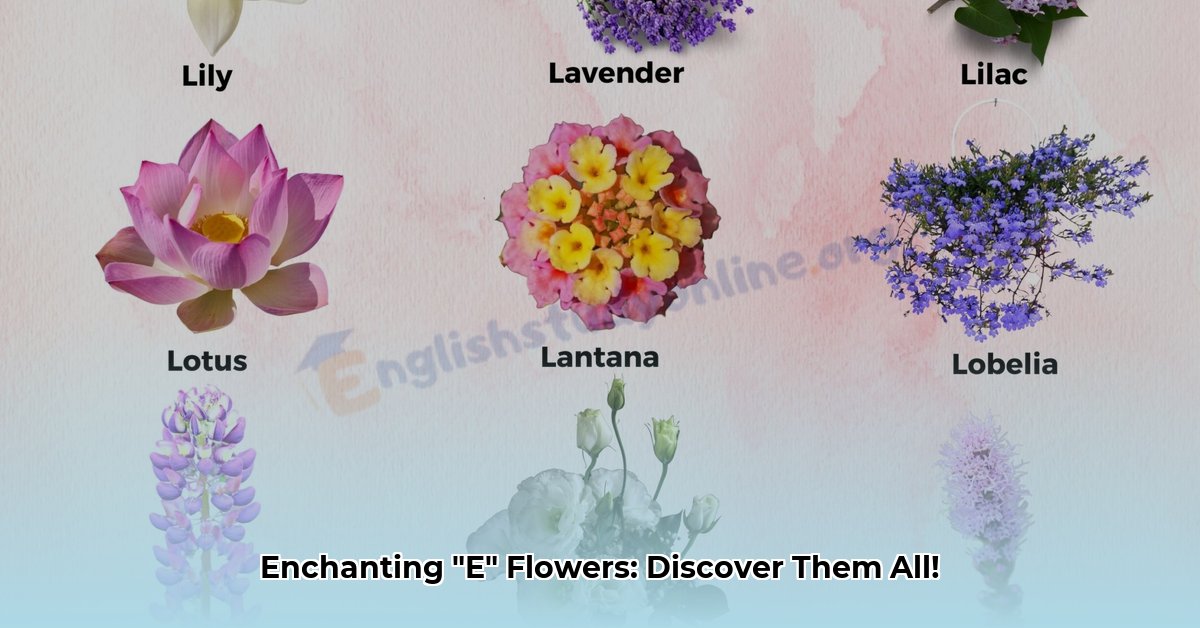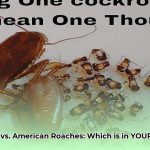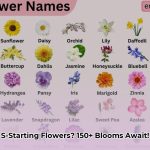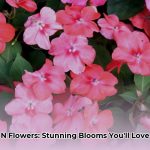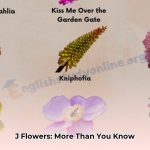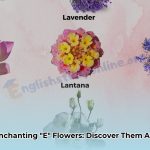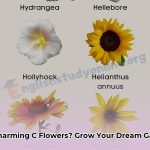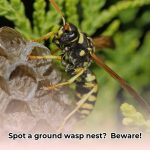Exploring the Enchanting World of “E” Flowers
The world of flowers offers a vast and vibrant tapestry of beauty, and sometimes, exploration by a single letter can lead to surprising discoveries. This guide delves into the captivating realm of flowers that begin with “E,” showcasing their diversity, from familiar garden favorites to exotic blooms.
Echinacea (Coneflower): A Prairie Powerhouse
Echinacea, commonly known as Coneflower, is a cheerful and resilient perennial. Its daisy-like blooms, featuring a prominent central cone composed of tiny florets, bring vibrant hues of purple, pink, white, and even yellow to gardens. Native to North America, Echinacea thrives in sunny locations with well-drained soil, tolerating drought and attracting butterflies with ease. Research suggests potential immune-boosting properties, adding another layer of interest to this beloved flower.
Echeveria: The Sculptural Succulent
Echeveria, while not a flower in the traditional sense, captivates with its striking rosette formations of fleshy leaves. These succulents, native to semi-desert regions, display an array of colors and textures, from powdery blue-green to deep reddish-brown. Their delicate, bell-shaped flowers, appearing on tall stalks, add a touch of whimsy. Echeverias are remarkably low-maintenance, requiring minimal watering and bright, indirect light.
English Bluebell: A Woodland Whisper
The English Bluebell (Hyacinthoides non-scripta) paints woodland floors with a breathtaking sea of vibrant blue. Their delicate, bell-shaped flowers, emitting a sweet, honey-like fragrance, are a treasured sight in spring. However, habitat loss and hybridization with the Spanish Bluebell pose threats, emphasizing the importance of conservation efforts.
Eranthemum: A Tropical Jewel
Eranthemum, also known as Blue Sage or Nerve Plant (though not a true sage), brings a splash of vibrant blue to tropical gardens. This shrub’s striking flowers and intricately veined leaves add exotic beauty. Native to India, Eranthemum thrives in warm, humid climates with dappled shade. While requiring slightly more attention than some other “E” flowers, its captivating appearance and ability to attract hummingbirds make it a rewarding addition.
Eustoma (Lisianthus): The Elegant Bloom
Eustoma, commonly called Lisianthus, is a florist’s favorite for its exquisitely delicate, rose-like blooms. Available in a spectrum of colors, from soft pastels to vibrant jewel tones, Lisianthus adds elegance to bouquets and gardens. Although potentially challenging to grow from seed, its stunning flowers are well worth the effort. It prefers full sun and well-drained soil, and pinching back can encourage bushier growth and more abundant blooms.
A Deeper Dive into “E” Flowers
Beyond the well-known, the “E” section of the floral alphabet holds a wealth of fascinating specimens. This section delves deeper into their unique characteristics and growing requirements.
Edelweiss: Symbol of the Alps
Edelweiss (Leontopodium alpinum), with its iconic star-shaped, fuzzy white flowers, evokes images of the Swiss Alps. This resilient plant thrives in well-drained, rocky soil and full sun to part shade. Surprisingly drought-tolerant, Edelweiss prefers dry conditions and dislikes overwatering. More about Edelweiss.
English Daisy: A Lawn’s Delight
The cheerful English Daisy (Bellis perennis) brightens lawns and meadows with its small, white, and yellow-centered blooms. These daisies prefer consistently moist, well-drained soil and full sun to part shade. They are easy to propagate by division or seed.
Emilia (Tassel Flower): A Touch of Fire
Emilia (Emilia javanica), also known as Tassel Flower, adds a fiery touch to gardens with its red, orange, and pink blooms. These easy-to-grow annuals thrive in full sun and well-drained soil. While tolerant of some dryness, regular watering encourages more prolific blooming.
Eranthis (Winter Aconite): Harbinger of Spring
Eranthis hyemalis, or Winter Aconite, is a small, cup-shaped yellow flower that emerges even before the last snow melts. This early bloomer thrives in partial shade and moist soil, bringing a cheerful promise of spring.
Epimedium (Barrenwort): Shade-Loving Beauty
Epimedium, also known as Barrenwort or Bishop’s Hat, thrives in shady locations, adding delicate beauty with its uniquely shaped flowers. Numerous varieties offer diverse foliage and bloom colors, making it a versatile choice for shade gardens.
Evening Primrose: Night-Blooming Beauty
Evening Primrose (Oenothera biennis) unfurls its delicate yellow flowers as dusk settles, releasing a sweet fragrance into the night air. This biennial plant prefers full sun and average soil. It is known for its oil, which is studied for potential health benefits.
Everlasting Daisy (Xerochrysum): Enduring Beauty
Everlasting Daisies (Xerochrysum bracteatum), also known as Strawflowers, retain their vibrant colors even after drying, making them ideal for dried arrangements. They prefer full sun and well-drained soil. Numerous varieties offer diverse colors, from sunny yellows to rich oranges and reds.
Growing “E” Flowers: Tips and Tricks
Cultivating “E” flowers offers a rewarding experience, but understanding their individual needs is crucial. Here are some essential tips to ensure their success:
- Soil: Most “E” flowers prefer well-drained soil. Amend heavy clay soils with organic matter to improve drainage.
- Light: While many “E” flowers thrive in full sun, some, like Epimedium and English Bluebell, prefer partial shade.
- Watering: Water deeply and regularly, especially during dry periods. However, avoid overwatering, which can lead to root rot. Echeveria and Edelweiss are particularly drought-tolerant.
- Propagation: Many “E” flowers can be easily propagated by seed or division.
A Table of “E” Flowers
| Flower Name | Scientific Name | Key Features | Growing Conditions |
|---|---|---|---|
| Echinacea | Echinacea spp. | Daisy-like, cone-shaped center, various colors | Full sun, well-drained soil |
| Echeveria | Echeveria spp. | Succulent, rosette form, various colors | Bright, indirect light, infrequent watering |
| Edelweiss | Leontopodium alpinum | Fuzzy white, star-shaped, drought-tolerant | Full sun to part shade, well-drained soil |
| Emilia | Emilia javanica | Tassel-like flowers, red, orange, pink | Full sun, well-drained soil |
| English Bluebell | Hyacinthoides non-scripta | Bell-shaped, blue, violet, or white | Partial shade, moist soil |
| English Daisy | Bellis perennis | Small, white or pink, yellow center | Full sun to part shade, moist soil |
| Epimedium | Epimedium spp. | Delicate, uniquely shaped flowers, shade-loving | Partial shade, well-drained soil |
| Eranthis | Eranthis hyemalis | Small, cup-shaped, yellow, early bloomer | Partial shade, moist soil |
| Eranthemum | Eranthemum pulchellum | Vibrant blue flowers, striking foliage | Partial shade, warm, humid climate |
| Eustoma (Lisianthus) | Eustoma grandiflorum | Rose-like blooms, various colors | Full sun, well-drained soil |
This guide provides a starting point for exploring the fascinating world of “E” flowers. Further research into specific varieties will reveal even more about their unique characteristics and optimal growing conditions. Happy gardening!
- Grass Forever in Livermore: Your Guide to Artificial Turf - April 22, 2025
- German Roaches vs. American Roaches: Key Differences and Control - April 22, 2025
- 150+ Flowers That Start With S: A Comprehensive Guide - April 22, 2025
